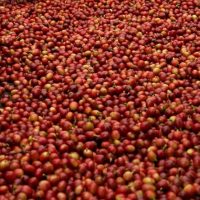 I began my Making Coffee at Home series in March 2020 as a response to the COVID-19 pandemic, offering simple, practical advice about how to make great coffee. Along the way, I started to write about the coffee itself, and, as time went on, this grew into a substantial series in its own right. Rather than keeping it as part of the Making Coffee at Home series, I’ve decided to spin it off into a series of its own, hence this page.
I began my Making Coffee at Home series in March 2020 as a response to the COVID-19 pandemic, offering simple, practical advice about how to make great coffee. Along the way, I started to write about the coffee itself, and, as time went on, this grew into a substantial series in its own right. Rather than keeping it as part of the Making Coffee at Home series, I’ve decided to spin it off into a series of its own, hence this page.
As well as the coffee series itself, I’ve also added various articles that I’ve written over the years about the cuppings I’ve attended as well as articles about tasting coffee. This last group I’ve filed under the category of coffee experiences, a wonderfully eclectic mix of pieces about the various things that change the way we perceive the taste of our coffee. Enjoy!
Coffee, Part I: Origins
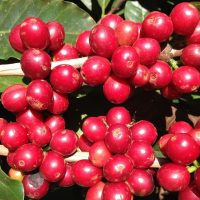 Welcome to another instalment of my Coffee at Home series. I began by focusing on brewing methods, with simple guides to the cafetiere, Clever Dripper and AeroPress. I’ve also written about equipment, such as grinders and scales. However, there’s something else I want to talk about. No matter how good your equipment is, how much you perfect your technique, there’s one thing it can’t fix, and that’s the quality of the coffee.
Welcome to another instalment of my Coffee at Home series. I began by focusing on brewing methods, with simple guides to the cafetiere, Clever Dripper and AeroPress. I’ve also written about equipment, such as grinders and scales. However, there’s something else I want to talk about. No matter how good your equipment is, how much you perfect your technique, there’s one thing it can’t fix, and that’s the quality of the coffee.
It’s easy to assume that everyone knows about coffee, but there was a point, before I started the Coffee Spot, when I knew very little. I clearly remember the sense of bewilderment when I first walked into a speciality coffee shop (Edinburgh’s Brew Lab), looked at the menu and realised that I had no idea what it was trying to tell me.
I’ll also say, from the outset, that if you are happy with the coffee you are currently buying/making, then that’s fine. Don’t let me, or anyone else, tell you otherwise. However, if you are dipping your toe into the world of speciality coffee for the first time and are wondering what tasting notes, varietals and processing are all about, then this is the post for you.
Continue reading...Coffee, Part II: Blends
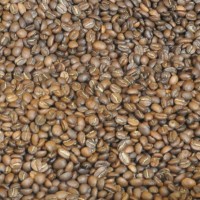 Welcome to another instalment of my Coffee at Home series, where once again, I’m looking at coffee. The Coffee at Home series aims to provide simple, practical advice on making coffee at home, although I deviated from this in Part I of my look at coffee, where I talked about the concepts of direct trade and single-origin coffee. However, this was to set the scene for what I want to talk about today, which is some advice on what to look for when buying coffee.
Welcome to another instalment of my Coffee at Home series, where once again, I’m looking at coffee. The Coffee at Home series aims to provide simple, practical advice on making coffee at home, although I deviated from this in Part I of my look at coffee, where I talked about the concepts of direct trade and single-origin coffee. However, this was to set the scene for what I want to talk about today, which is some advice on what to look for when buying coffee.
When I started the Coffee Spot, back in 2012, my knowledge of coffee was very limited. To me, coffee was just coffee. However, I quickly realised that it was way more complicated than that, something which can be rather daunting when you’re dipping your toe into the world of speciality coffee for the first time and trying to order some coffee on-line from a speciality roaster. To help you out, I’ll be unpacking some of the terms that I now take for granted, but which back then I found rather baffling. Having introduced you to the concept of single-origins, I now want to talk about blends, which is how the majority of coffee is sold.
Continue reading...Coffee, Part III: Tasting Notes
 Welcome to the third instalment of my Coffee at Home sub-series where I look at the coffee itself. In Part I, I looked at the concepts of direct trade and why knowing where your coffee comes from is important. Meanwhile, Part II was all about blends, the art of combining different coffees in order to create a specific taste profile, which neatly leads us onto this, Part III, which is all about why coffee tastes the way it does.
Welcome to the third instalment of my Coffee at Home sub-series where I look at the coffee itself. In Part I, I looked at the concepts of direct trade and why knowing where your coffee comes from is important. Meanwhile, Part II was all about blends, the art of combining different coffees in order to create a specific taste profile, which neatly leads us onto this, Part III, which is all about why coffee tastes the way it does.
So, what affects the way a coffee tastes? Well, it turns out pretty much everything. The specific bean, where it’s grown, the altitude, the amount of sunshine, how its picked, how its processed, how its roasted… And that’s all before it gets to you, since how you make your coffee throws another variable into the mix.
It’s a subject that you could write books about, so I’m not going to be able to cover everything in one blog post. In fact, I’m going to write several, starting with a quick guide on tasting notes and how to read the information on coffee packaging. I’ll also nail a common misconception while I’m at it.
Continue reading...Coffee, Part IV: Processing & Roasting
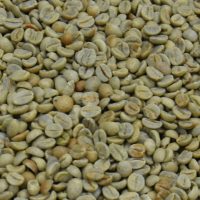 Welcome to the fourth instalment of my Coffee at Home sub-series looking at the coffee itself. In Part I, I looked at the concepts of direct trade and explained why knowing where your coffee comes from is important. Part II, meanwhile, was all about blends, the art of combining different coffees in order to create a specific taste profile, which neatly leads us Parts III and IV, which are all about why coffee tastes the way it does.
Welcome to the fourth instalment of my Coffee at Home sub-series looking at the coffee itself. In Part I, I looked at the concepts of direct trade and explained why knowing where your coffee comes from is important. Part II, meanwhile, was all about blends, the art of combining different coffees in order to create a specific taste profile, which neatly leads us Parts III and IV, which are all about why coffee tastes the way it does.
In previous instalment (Part III), I introduced the idea that pretty much everything has an impact on how your coffee tastes, all the way from the farm to the roaster. I also nailed a common misconception that coffee from a certain country/region tastes in a particular way. Finally, I provided some (hopefully) useful advice on tasting notes and how to read the information on coffee packaging.
In this, Part IV, I’m looking at what, for me at least, are the two biggest factors determining a coffee’s flavours. The first, which takes place at origin, is processing, while the other is the final step before the coffee gets to you/the coffee shop, namely roasting. Hopefully, I’ll be able to unpack some of the mystery!
Continue reading...Coffee, Part V: Taste
 Welcome to this, the fifth and (for now) final instalment of my Coffee at Home sub-series looking at coffee. I started the series with the concept of direct trade, explaining why knowing where your coffee comes from is important. I followed that by considering blends, the art of combining different coffees in order to create a specific taste profile. In the third instalment, I introduced the idea that pretty much everything has an impact on how your coffee tastes, all the way from the farm to the roaster, before looking at what are, for me, the two biggest factors: processing and roasting. Which brings us neatly to this fifth instalment, how preparing and serving your coffee affects how it tastes.
Welcome to this, the fifth and (for now) final instalment of my Coffee at Home sub-series looking at coffee. I started the series with the concept of direct trade, explaining why knowing where your coffee comes from is important. I followed that by considering blends, the art of combining different coffees in order to create a specific taste profile. In the third instalment, I introduced the idea that pretty much everything has an impact on how your coffee tastes, all the way from the farm to the roaster, before looking at what are, for me, the two biggest factors: processing and roasting. Which brings us neatly to this fifth instalment, how preparing and serving your coffee affects how it tastes.
At a very basic level, how you prepare your coffee obviously effects its taste. An espresso tastes very different from a pour-over, even using the same bean. However, the effects can be more subtle than that, which is what I want to explore in this post. It also goes beyond the basics such as preparation method. Almost everything changes how you perceive flavour, from the temperature of the coffee right down to the shape of the cup.
Continue reading...Roasting Green Beans at Home
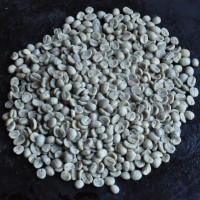 Back in November, I visited the delightful Finca in Dorchester. As well as being a lovely café, Finca also roasts all its own coffee using a bright-red, 1kg Genesis CBR-1200, which sits proudly on the counter. While I was there, the owner, Don, explained how he’d started roasting at home in a wok. As a parting gift, he gave me 4oz of green beans (Finca Muxbal from Mexico), plus a set of instructions for roasting them in Finca’s CBR-1200. Perhaps more relevant to me, the instructions also included a section roasting at home in a wok.
Back in November, I visited the delightful Finca in Dorchester. As well as being a lovely café, Finca also roasts all its own coffee using a bright-red, 1kg Genesis CBR-1200, which sits proudly on the counter. While I was there, the owner, Don, explained how he’d started roasting at home in a wok. As a parting gift, he gave me 4oz of green beans (Finca Muxbal from Mexico), plus a set of instructions for roasting them in Finca’s CBR-1200. Perhaps more relevant to me, the instructions also included a section roasting at home in a wok.
So, two weeks into January, the Coffee Spot Awards safely out of the way, I decided to give it a go. After reading and re-reading the instructions (that’s got to be a first for me), I set up the kitchen, opened all the windows and kept the door to living room (where the smoke alarm lives) firmly shut. As it turned out, there wasn’t much smoke, but it would have been enough to set the alarm off and I’m glad I ventilated the room. 30 minutes after roasting, a pleasant, slightly smoky smell still lingered in the kitchen.
Continue reading...Cupping
Chimney Fire Coffee: El Salvador Three Ways
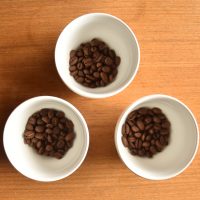 I started 2021 with a new Meet the Roaster, featuring the lovely folk at Chimney Fire Coffee. I ended that post with a promise to tell you more about Chimney Fire’s coffee, and specifically the El Salvador Three Ways, a direct trade coffee from the Don Tomas Estate in El Salvador, where the same coffee has been processed three different ways: natural, washed and honey processed.
I started 2021 with a new Meet the Roaster, featuring the lovely folk at Chimney Fire Coffee. I ended that post with a promise to tell you more about Chimney Fire’s coffee, and specifically the El Salvador Three Ways, a direct trade coffee from the Don Tomas Estate in El Salvador, where the same coffee has been processed three different ways: natural, washed and honey processed.
This post is mostly about the El Salvador, but I did want to briefly mention the rest of Chimney Fire’s excellent range. There’s the Ranmore signature espresso blend, plus a classic espresso from Peru and a sugar cane decaf from Colombia. Added to that is a selection of around five single-origins which, depending on the coffee, are roasted with espresso or filter in mind, or, if it works for the coffee, an omni-roast which means that it should work equally well as espresso or filter.
Finally, if you want something more challenging, there’s the Discovery Range. This has a different, limited-edition coffee each month, but Chimney Fire won’t tell you where it’s from ahead of time, just providing tasting notes, the idea being that you should focus more on the flavour than the origin!
Continue reading...Cupping at Tandem Coffee Roasters
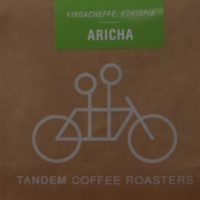 Although a big advocate of cuppings, I rarely get the chance to attend them, so when an opportunity comes along, I tend to grab it with both hands. I was visiting Amanda in Portland last summer when the barista at the Tandem Coffee Roastery mentioned that the roastery holds public cuppings every Friday at noon: naturally, I had to go. Ironically, having not been to a cupping for a while, this was my second one that year, both in the USA.
Although a big advocate of cuppings, I rarely get the chance to attend them, so when an opportunity comes along, I tend to grab it with both hands. I was visiting Amanda in Portland last summer when the barista at the Tandem Coffee Roastery mentioned that the roastery holds public cuppings every Friday at noon: naturally, I had to go. Ironically, having not been to a cupping for a while, this was my second one that year, both in the USA.
In case you don’t know, a cupping is where several different coffees are tasted using a standard methodology, which allows their taste profiles to be compared without the brew method, etc, influencing the results. They’re a regular part of any roaster’s life, often used to assess new samples before deciding which beans to order. However, in this case, the cupping was part of Tandem’s quality control procedure for its production roasts.
Increasingly, roasters are opening up their production cuppings to the public. It’s a great opportunity to get to know more about a roaster and the coffees on offer, as well as a chance to develop your own palate. I thoroughly recommend that you attend one if you can!
Continue reading...Japanese Coffee Cupping
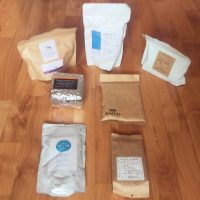 So there I was, minding my own business at the London Coffee Festival, when I ran into Lisa of Dear Green Coffee, organiser of the Glasgow Coffee Festival. Rather foolishly, I mentioned that I was flying to Japan that week, returning just in time for the festival. Well, said Lisa, in that case, why not bring back some Japanese coffee and we can have a cupping? Why not indeed…
So there I was, minding my own business at the London Coffee Festival, when I ran into Lisa of Dear Green Coffee, organiser of the Glasgow Coffee Festival. Rather foolishly, I mentioned that I was flying to Japan that week, returning just in time for the festival. Well, said Lisa, in that case, why not bring back some Japanese coffee and we can have a cupping? Why not indeed…
Fast-forward two weeks and there I am in Tokyo, thinking that I really should get do something about my rather spur-of-the-moment agreement to Lisa’s proposal. Fortunately, I’d just embarked on a week’s travelling around Japan, so was able to pick up a rather eclectic mix of Japanese-roasted coffee.
Like my trip, there was no great planning involved in my purchasing, which might explain why I brought back with three Kenyans, two Ethiopians and a pair from Costa Rica. Typically I either bought something I’d tried (such as the Ethiopian I picked up from Kaido Books And Coffee) or I asked for recommendations. With hindsight, I rather wished I’d got some of the aged Kenyan coffee I had at Café de L’Ambre, but alas that thought only came to me five minutes ago…
Continue reading...Meet the Roaster: Chromatic Coffee
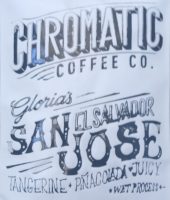 Serendipity’s always played a large part in the Coffee Spot, even from its inception over seven years ago when someone said “why don’t you start a basketball blog” and I thought “a coffee blog! What an excellent idea!”. No matter how much I plan, chance discovery always plays its part and today’s Meet the Roaster is no exception
Serendipity’s always played a large part in the Coffee Spot, even from its inception over seven years ago when someone said “why don’t you start a basketball blog” and I thought “a coffee blog! What an excellent idea!”. No matter how much I plan, chance discovery always plays its part and today’s Meet the Roaster is no exception
Visiting Chromatic Coffee was always part of the plan for my return to San Jose earlier this year. I’d heard great things about the coffee shop from my friend Richard on my first visit in 2017. Getting out to Santa Clara was also going to be the issue, so when Richard offered to drop me off on his way to work, I jumped at the chance.
Before I left, I had a long chat with the manager, who, on learning that I was staying in San Jose until the end of the week, suggested attending Chromatic’s public cupping, which takes place in the roastery every Thursday morning. And that led to me discovering that Chromatic’s roastery is a couple of blocks from Richard’s flat.
Naturally I went, enjoying not just the cupping, but also receiving a tour of the roastery to boot!
Continue reading...Small Batch Cupping at Finisterre
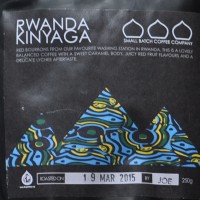 On Thursday last week, I was fortunate enough to be invited to a cupping being held by Brighton roaster, Small Batch, although rather than having to go all the way down to the south coast, I just had to pop along to Seven Dials and surf shop, Finisterre. While this may seem a strange location for a coffee cupping, it makes more sense than you think, since Finisterre, as well as being a surf shop, also has a lovely little coffee shop, serving Small Batch (although you’d probably already guessed that at this point).
On Thursday last week, I was fortunate enough to be invited to a cupping being held by Brighton roaster, Small Batch, although rather than having to go all the way down to the south coast, I just had to pop along to Seven Dials and surf shop, Finisterre. While this may seem a strange location for a coffee cupping, it makes more sense than you think, since Finisterre, as well as being a surf shop, also has a lovely little coffee shop, serving Small Batch (although you’d probably already guessed that at this point).
The guys from Small Batch (head-roaster, Al; barista trainer, Laura; and Dan) were joined by Cory from green-bean importers, Falcon. Cory was there due to his experience in Africa, where he’s been working on building links with local farmers, helping them grow sustainable coffee businesses. Cory’s presence was important because this was no ordinary cupping. Instead, Small Batch was showing-casing its range of coffee from Rwanda, with six coffees in all, each from a different washing station (all the coffees are named after the washing station which processed them). There was also a seventh coffee, a Shembati Buziraguindwa from neighbouring Burundi, to provide some contrast.
Continue reading...Coffee Experiences
Birthday Coffee Tasting
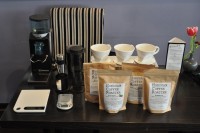 I celebrated my birthday last weekend by inviting a group of friends down to the closest thing I have to a local, Guildford’s Bar des Arts, for a coffee tasting. I'd originally been given the idea by Lee Hall of Matthew Algie when he did a similar demo at the Caffé Culture Show. There he put two different coffees through a pour-over filter and a Chemex and I was astounded by how different they tasted.
I celebrated my birthday last weekend by inviting a group of friends down to the closest thing I have to a local, Guildford’s Bar des Arts, for a coffee tasting. I'd originally been given the idea by Lee Hall of Matthew Algie when he did a similar demo at the Caffé Culture Show. There he put two different coffees through a pour-over filter and a Chemex and I was astounded by how different they tasted.
So, when thinking about how I wanted to celebrate my birthday, I could think of nothing better than surrounding myself with some friends and replicating this experiment. I approached Bradley of Horsham Coffee Roaster, who supplies Bar des Arts, and he provided three very different coffees for us to try. Meanwhile, I brought along my trusty Aeropress (and one of the guests, Richard, brought his down) to go with Bar des Arts pour-over filters and cafetiere.
So, the scene was set for an afternoon of good company, coffee tasting and cake (although, very disappointingly, I seem to have taken exactly no pictures of the cake!).
Continue reading...Coffee Experience at Queens of Mayfair
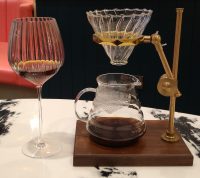 This summer, something very special happened in the heart of Mayfair with the opening of Queens of Mayfair, best described as a high-end coffee, brunch and cocktails spot. That in itself is not that special, since the coffee, brunch and cocktails market is already well served, particularly in London. What makes Queens stand out is the quality of the coffee, with an espresso-based menu featuring a Brazilian Daterra, roasted for Queens by Difference Coffee. However, I covered all that when I wrote up Queens in its own Coffee Spot earlier this week. So what is it that makes Queens so special?
This summer, something very special happened in the heart of Mayfair with the opening of Queens of Mayfair, best described as a high-end coffee, brunch and cocktails spot. That in itself is not that special, since the coffee, brunch and cocktails market is already well served, particularly in London. What makes Queens stand out is the quality of the coffee, with an espresso-based menu featuring a Brazilian Daterra, roasted for Queens by Difference Coffee. However, I covered all that when I wrote up Queens in its own Coffee Spot earlier this week. So what is it that makes Queens so special?
The answer is its coffee service, which caught the headlines with what has been tagged as UK’s most expensive cup of coffee, which comes with an eye-watering £50. For that, you get a very exclusive micro-lot of an Ethiopian Cup of Excellence winner. However, in fairness to Queens, describing it as a £50 cup of coffee hardly does it justice since you are a paying for a whole lot more than just a cup of coffee. Instead, you are paying for a whole coffee experience, something which, when I visited Queens last week, I had to try for myself.
Continue reading...Coffee Tasting Flight at Slate
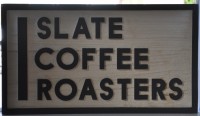 Every now and then something comes along that is so special that it immediately jumps out at you. Such is the case with the wonderful Slate Coffee Roasters of Seattle and its amazing coffee tasting flight. Slate is a coffee shop/roaster that has been going for a couple of years now and somewhere where the focus is more clearly on the coffee than anywhere else I’ve been. Nowhere is this more apparent than in the coffee tasting flight.
Every now and then something comes along that is so special that it immediately jumps out at you. Such is the case with the wonderful Slate Coffee Roasters of Seattle and its amazing coffee tasting flight. Slate is a coffee shop/roaster that has been going for a couple of years now and somewhere where the focus is more clearly on the coffee than anywhere else I’ve been. Nowhere is this more apparent than in the coffee tasting flight.
I’ve written about Slate as a Coffee Spot in its own right, while this Saturday Supplement is solely about a detailed description of the coffee tasting flight because I feel it deserves the attention. I’d already been forewarned by my friend Kate Beard about Slate and its amazing deconstructed espresso (more of which later), but it was the coffee tasting flight that jumped out at me, partly because it has no price attached.
Why? Because the coffee tasting flight is pretty much what you make of it and its charged accordingly. Think of it as a 45 minute, personal curated coffee tour. Want to taste the same coffee four different ways? No problem. Want to explore the differences between processing methods? You got it.
June 2019: My visit to Slate was one of my personal Coffee Spot highlights. I'm therefore deeply saddened to learn of reports of mistreatment of the staff.
Continue reading...Discourse Coffee
 If you haven’t worked it out already, I’m in America, the Midwest to be precise, taking a long road trip that began in Chicago, with me working my way up the west coast of Lake Michigan, stopping at Kickapoo Coffee in Milwaukee. Today’s Coffee Spot is from Door County, the peninsular that sticks out into the lake north/east of Green Bay. I went there to enjoy the countryside and the lake views, but much like Flagstaff earlier in the year, I found great coffee as well, this time in the shape of Discourse Coffee, which subtitles itself “a liquid workshop”.
If you haven’t worked it out already, I’m in America, the Midwest to be precise, taking a long road trip that began in Chicago, with me working my way up the west coast of Lake Michigan, stopping at Kickapoo Coffee in Milwaukee. Today’s Coffee Spot is from Door County, the peninsular that sticks out into the lake north/east of Green Bay. I went there to enjoy the countryside and the lake views, but much like Flagstaff earlier in the year, I found great coffee as well, this time in the shape of Discourse Coffee, which subtitles itself “a liquid workshop”.
Run by the friendly and enthusiastic Ryan since July 2017, Discourse will take you on a journey through coffee. As well as offering a standard(ish) espresso-based menu from the single-group Slayer on the counter, there’s batch-brew and pour-over using the innovative Phoenix 70 dripper from Saint Anthony Industries. However, the fun’s only just starting, since Discourse offers a regularly-changing cast of latte-based drinks with some very interesting flavour combinations. All this is served in a lovely, cosy, basement-like space that you really have to seek out, so the only people who are there are those who really want to be.
Continue reading...Fazenda Recanto: A Tale of Two Roasters
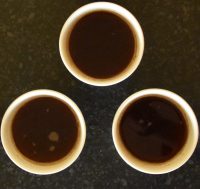 Last month I wrote a post called Freak & Unique (and Other Coffees), featuring the Freak & Unique range from Hundred House Coffee, along with two other coffees that I’d been given when visiting the roastery at the end of April. Originally, I’d intended the post to be mostly about the Freak & Unique, but it was actually another of the coffees, the Fazenda Recanto from Brazil, which is processed using a 64-hour fermentation technique, that became the star of the piece.
Last month I wrote a post called Freak & Unique (and Other Coffees), featuring the Freak & Unique range from Hundred House Coffee, along with two other coffees that I’d been given when visiting the roastery at the end of April. Originally, I’d intended the post to be mostly about the Freak & Unique, but it was actually another of the coffees, the Fazenda Recanto from Brazil, which is processed using a 64-hour fermentation technique, that became the star of the piece.
One of the interesting things about the Fazenda Recanto was that Hundred House bought it as an exclusive nano-lot along with two other roasters, Crankhouse Coffee and Quarter Horse Coffee Roasters. I really wanted to get my hands on more of the Fazenda Recanto, which is easily my favourite coffee of the year so far, and I was about to buy another bag from Hundred House when I had an idea: why didn’t I get a bag each from Crankhouse and Quarter Horse to see if the roaster made a difference to how the coffee tasted? So that’s what I did, except, of course, like most of my plans, things didn’t quite work out as I’d hoped…
Continue reading...Frozen Solid Coffee Project
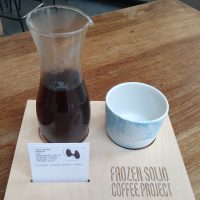 Something rather special is happening at Tilt, Birmingham’s speciality coffee, craft beer and pinball joint. Tilt has been serious about its coffee ever since it opened, but recently Tilt’s owner, Kirk, has taken things to a whole new level. For example, there is a continuous rotation of guest roasters on espresso, with Tilt using coffee from around the world. Right now, Tilt is serving a single-origin from Manhattan Coffee Roasters (from Rotterdam in the Netherlands), which replaced one from Onyx Coffee Lab (from Arkansas in the US). However, the really exciting thing, exciting enough to have this whole Saturday Supplement dedicated to it, is the Frozen Solid Coffee Project.
Something rather special is happening at Tilt, Birmingham’s speciality coffee, craft beer and pinball joint. Tilt has been serious about its coffee ever since it opened, but recently Tilt’s owner, Kirk, has taken things to a whole new level. For example, there is a continuous rotation of guest roasters on espresso, with Tilt using coffee from around the world. Right now, Tilt is serving a single-origin from Manhattan Coffee Roasters (from Rotterdam in the Netherlands), which replaced one from Onyx Coffee Lab (from Arkansas in the US). However, the really exciting thing, exciting enough to have this whole Saturday Supplement dedicated to it, is the Frozen Solid Coffee Project.
I was completely unaware of the Frozen Solid Coffee Project when I visited Tilt two weeks ago, only realising that it was there when Kirk pointed it out to me on the menu. Indeed, it’s the sort of thing that you can easily miss if you don’t already know about it. For the uninitiated, the Frozen Solid Coffee Project enables Tilt to offer an extremely wide range of single-origin pour-overs (29 at the time of writing!) from farms/roasters around the world, some of which are extremely rare micro- and nano-lots.
Continue reading...Il Grifone at Prufrock
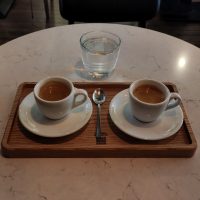 Today’s Coffee Spot is part Saturday Supplement and part Coffee Spot Update. Earlier this year, James Hoffmann went to Milan where he met Enrico Maltoni, who restores vintage espresso machines. One thing led to another, with James buying a 1958 Faema President lever espresso machine, which Enrico restored. Fast forward a few months and the Faema was delivered, in full working order, to London, where James had decided to install it, on a temporary basis, in the legendary Prufrock Coffee, Square Mile’s coffee shop on Leather Lane in Shoreditch.
Today’s Coffee Spot is part Saturday Supplement and part Coffee Spot Update. Earlier this year, James Hoffmann went to Milan where he met Enrico Maltoni, who restores vintage espresso machines. One thing led to another, with James buying a 1958 Faema President lever espresso machine, which Enrico restored. Fast forward a few months and the Faema was delivered, in full working order, to London, where James had decided to install it, on a temporary basis, in the legendary Prufrock Coffee, Square Mile’s coffee shop on Leather Lane in Shoreditch.
However, James being James, there was more to it than that. Rather than use a modern blend, like Square Mile’s ubiquitous Red Brick, James and the team at Square Mile developed a limited-edition blend, Il Grifone, specifically designed for the lever espresso machine, with the option of trying it side-by-side with a shot of Red Brick, pulled on the modern Black Eagle espresso machine. All of this was explained in a video that James posted on his YouTube channel two weeks ago. As luck would have it, I was passing through London the following week, so naturally I made my way to Prufrock, my first visit there in many a year.
Continue reading...London Coffee Festival 2015: La Cimbali Sensory Sessions
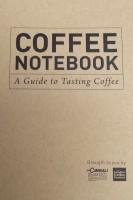 Welcome to the third of my detailed London Coffee Festival Saturday Supplements. If you want to know what I made of the festival as a whole, take a look at my round-up. In this series, I’ll be covering individual aspects of the festival. In the first two instalments I’ve looked at all the interesting coffee kit that I came across and written about my coffee experiences. Now it’s the turn of something quite special.
Welcome to the third of my detailed London Coffee Festival Saturday Supplements. If you want to know what I made of the festival as a whole, take a look at my round-up. In this series, I’ll be covering individual aspects of the festival. In the first two instalments I’ve looked at all the interesting coffee kit that I came across and written about my coffee experiences. Now it’s the turn of something quite special.
I’ve recently returned from the Pacific Northwest, where I had the pleasure of visiting the likes of Portland’s Either/Or, with its espresso and beverage flights, and Seattle’s Slate Coffee Roasters where I had an amazing, one-on-one coffee tasting flight. To follow that up, I want to tell you about one of the highlights of this year’s Coffee Festival, the excellent La Cimbali sensory sessions.
Located in the main hall, about halfway up on the left-hand side, La Cimbali has always brought innovative ideas to the London Coffee Festival, but this year it surpassed itself with its sensory sessions. These highlighted the impact of taste (and our other senses) on how we perceive coffee and on how the way we prepare coffee can radically change our perceptions.
Continue reading...London Coffee Festival 2019: Coffee Experiences
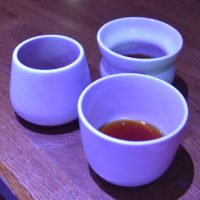 Welcome to the third and final detailed write-up of the 2019 London Coffee Festival, which took place last month at the Old Truman Brewery. Along with my overall Festival Round-up, so far I’ve written about the coffee and the coffee kit. Today’s the turn of one of my festival highlights, my coffee experiences.
Welcome to the third and final detailed write-up of the 2019 London Coffee Festival, which took place last month at the Old Truman Brewery. Along with my overall Festival Round-up, so far I’ve written about the coffee and the coffee kit. Today’s the turn of one of my festival highlights, my coffee experiences.
But what do I mean by “coffee experiences”? These are the events that go around the coffee itself, such as coffee cuppings, roasting demos and coffee/food pairings. They’ve been very popular over recent years, with the festival running practical, skills-based events such as Latte Art Live and Home Barista Workshops. There have also been experiences such as The Tasting Room (with subjects ranging from tea to Vermouth) and The Flavour Discovery, a multi-sensory journey from Union Hand-roasted!
As in previous years, most of these events were pre-ticketed, with limited numbers at each event. As a result, I only attended one, the annual La Cimbali Sensory Series, which I only managed to attend thanks to a kind invitation from La Cimbali! Hosted by the fabulous Rob Ward, he manages, year after year, to invent with some new way to challenge the senses and educate at the same time.
Continue reading...Maruyama Coffee Experiences
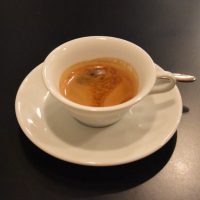 Earlier this week, I wrote about the Maruyama Single Origin store in Aoyama, one of my favourite after-work haunts when I’m working in Tokyo (although I since learnt that it has closed). It’s a lovely coffee shop in its own right, offering the sort of high-end service that I’ve come to expect from visits to other Maruyama locations, such as Nishi Azabu and Nagano Station. However, the single origin store goes one step further, with the focus even more firmly on the coffee.
Earlier this week, I wrote about the Maruyama Single Origin store in Aoyama, one of my favourite after-work haunts when I’m working in Tokyo (although I since learnt that it has closed). It’s a lovely coffee shop in its own right, offering the sort of high-end service that I’ve come to expect from visits to other Maruyama locations, such as Nishi Azabu and Nagano Station. However, the single origin store goes one step further, with the focus even more firmly on the coffee.
As well as only serving single-origins (a typical Maruyama will have seven different blends), there are delights such as an espresso and cappuccino set (effectively a split shot or one-and-one) and, a new one on me, the same espresso served in two different cups. About the only thing that Maruyama Single Origin doesn’t offer is a filter tasting flight, but since there are always four or five samples for you try on the downstairs counter, it’s almost the same thing.
Naturally, I had to indulge, and, over the span of several visits, I put these various coffee experiences through their paces. Rather than try to cram them all into my write-up of Maruyama Single Origin, I decided to dedicate this Saturday Supplement to my experiences.
Continue reading...Pour-over at Roscioli Caffè
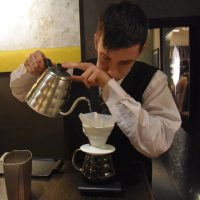 My trip to Rome at the start of the month was, as might be expected given Rome’s espresso culture, dominated by espresso. I also didn’t help myself, visiting the likes of Tazza D’Oro and near-neighbour, Sant' Eustachio Il Caffè. That said, if you look hard enough, you can find pour-over, usually hand-in-hand with speciality coffee. Most prominent of the places I visited was Faro, the self-proclaimed first speciality coffee shop in Rome. Pour-over was also on offer at The Tram Depot, although when we ordered some one evening we were told that the barista who knew how to do pour-over had gone home. To the staff’s credit, they didn’t want to serve us badly-made coffee, so politely declined (we had espresso instead).
My trip to Rome at the start of the month was, as might be expected given Rome’s espresso culture, dominated by espresso. I also didn’t help myself, visiting the likes of Tazza D’Oro and near-neighbour, Sant' Eustachio Il Caffè. That said, if you look hard enough, you can find pour-over, usually hand-in-hand with speciality coffee. Most prominent of the places I visited was Faro, the self-proclaimed first speciality coffee shop in Rome. Pour-over was also on offer at The Tram Depot, although when we ordered some one evening we were told that the barista who knew how to do pour-over had gone home. To the staff’s credit, they didn’t want to serve us badly-made coffee, so politely declined (we had espresso instead).
Perhaps the most surprising find was Roscioli Caffè Pasticceria. A few minutes’ walk from the hotel my friend Amanda and I were staying at, we became daily visitors, enjoying single-origin espressos from Laboratorio Di Torrefazione Giamaica Caffè, along with some excellent patisserie. It was only on our fourth visit that I noticed V60s nestling alongside the bags of coffee, which is when I realised that Roscioli serves pour-over too. That evening we naturally popped back to order some…
Continue reading...Tasting Flights at Glitch Coffee
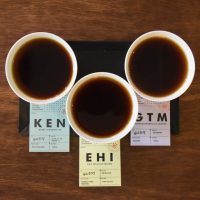 Tokyo’s speciality coffee scene is incredibly varied, ranging from international brands and traditional kissaten to small, home-grown coffee shop/roasters, absorbing global influences to forge their own identities. Yesterday’s Coffee Spot, Glitch Coffee & Roasters, definitely falls into the latter category and is one of the most innovative coffee shops that I’ve visited in Tokyo. Best of all, it’s served me some truly outstanding coffee, the subject of today’s Saturday Supplement.
Tokyo’s speciality coffee scene is incredibly varied, ranging from international brands and traditional kissaten to small, home-grown coffee shop/roasters, absorbing global influences to forge their own identities. Yesterday’s Coffee Spot, Glitch Coffee & Roasters, definitely falls into the latter category and is one of the most innovative coffee shops that I’ve visited in Tokyo. Best of all, it’s served me some truly outstanding coffee, the subject of today’s Saturday Supplement.
Glitch roasts on a 5kg Probat, tucked away on the right-hand side of the coffee shop in full view of the customers. Concentrating on lightly-roasted single-origins, two of which are on espresso, the real star is the pour-over. There’s a row V60s along the front of the counter, each with a glass jar of beans and a card giving tasting notes and details of the origin.
While you can order by the cup, I was drawn to the tasting flights, which allow you to try two or three of the single-origin pour-overs (chosen by Glitch) side-by-side. So drawn, in fact, that today’s post is all about the two tasting flights I’ve had, the first in 2018 and the other last weekend at the end of my most recent trip.
Continue reading...Three Micro-lots from Crankhouse
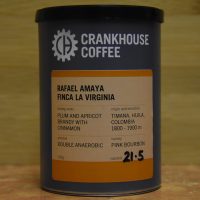 The Coffee Spot has always been more about places I like to have coffee than about the coffee itself, so I find it amusing that today’s Saturday Supplement is the fourth about coffee in a month! This can be traced back to the Freak & Unique that I received from Hundred House Coffee, the gift that keeps on giving. Along with the Freak & Unique, which spawned a second post when I tried it at Liar Liar, I received a bag of Fazenda Recanto, a coffee from the Cerrado Minerio region of Brazil, which is processed using a 64-hour fermentation technique.
The Coffee Spot has always been more about places I like to have coffee than about the coffee itself, so I find it amusing that today’s Saturday Supplement is the fourth about coffee in a month! This can be traced back to the Freak & Unique that I received from Hundred House Coffee, the gift that keeps on giving. Along with the Freak & Unique, which spawned a second post when I tried it at Liar Liar, I received a bag of Fazenda Recanto, a coffee from the Cerrado Minerio region of Brazil, which is processed using a 64-hour fermentation technique.
The Fazenda Recanto was a nano-lot which Hundred House bought in conjunction with Crankhouse Coffee and Quarter Horse Coffee Roasters. I was trying to buy a bag from each roaster so that I could compare all three, but sadly, Crankhouse had sold out. However, while I was looking around the Crankhouse website, I came across three other very special coffees which caught my eye. All three coffees were processed, like the Fazenda Recanto, with various fermentation techniques, so I decided to buy them instead.
Continue reading...Trying Eugenioides at Terremoto
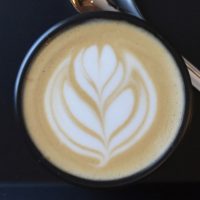 In the wild, coffee has over 120 individual species. However, two species dominate commercially grown coffee: Arabica and Robusta, with Arabica accounting for the vast majority of speciality coffee. Other species are occasionally commercially grown, and last weekend at Terremoto Coffee in New York, Amanda and I were presented with Coffea eugenioides, a rare species indigenous to the East African highlands, including Democratic Republic of Congo, Rwanda, Uganda, Kenya and western Tanzania.
In the wild, coffee has over 120 individual species. However, two species dominate commercially grown coffee: Arabica and Robusta, with Arabica accounting for the vast majority of speciality coffee. Other species are occasionally commercially grown, and last weekend at Terremoto Coffee in New York, Amanda and I were presented with Coffea eugenioides, a rare species indigenous to the East African highlands, including Democratic Republic of Congo, Rwanda, Uganda, Kenya and western Tanzania.
Coffea eugenioides (Eugenioides for short) is, in fact, one of Arabica’s two parent species, the other being Robusta. The Eugenioides at Terremoto was roasted by Neat, a roaster/importer in Darien, Connecticut, and comes from a farm, Las Nubes, in Colombia. Naturally, we had to try it, ending up with a pour-over, an espresso and, to try it in milk, a cortado. Our barista also provided us with a shot of the house espresso (a washed Colombian) and a batch brew sample (a washed Honduran) for comparison!
Normally, I’d write this up as part of my description of the coffee shop, but since Eugenioides is so different from anything that I’ve tried before, I’ve dedicated this entire Saturday Supplement to it, with Terremoto featuring in its own Coffee Spot.
Continue reading...Return to the main Coffee at Home page.
